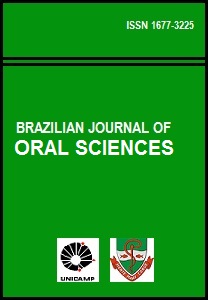Abstract
The cementation of thin ceramic veneers employing fluid light-activated resin-based materials is a common procedure in the dental practice. Aim: To evaluate the influence of ceramic thickness and shade on the degree of conversion (DC) of a flowable light-activated material. Methods: flowable resin composite (Tetric N-Flow – shade A1) was light-activated through ceramic discs of two shades (IPS Classic - A1 and A3) in three thicknesses (0.5, 0.7 and 1.0 mm). For control, the resin composite was light-activated without ceramic interposition. DC was evaluated by FTIR (n=5). Data were analyzed by one-way ANOVA and Dunnett’s T3 test (α=0.05). Results: Statistically significant differences between groups were observed (p<0.001). Control group (without the interposition of ceramic) showed the highest mean for DC (71.9± 1.7). Considering the interposed ceramic disc groups, the highest DC values were obtained when 0.5 and 0.7 mm A1 ceramics were used (64.6±1.2 and 64.4 5.0, respectively) and the lowest DC values were obtained for 0.7 and 1 mm A3 ceramics (61.74±0.9 and 62.0±1.9, respectively). Conclusions: No flowable resin composite group with interposing ceramics reached a DC similar to the control group
References
Lawson NC, Burgess JO. Dental ceramics: a current review. Compend Contin Educ Dent. 2014; 35: 161-6.
Manso AP, Silva NR, Bonfante EA, Pegoraro TA, Dias RA, Carvalho RM. Cements and adhesives for all-ceramic restorations. Dent Clin North Am. 2011; 55: 311-32.
Rosenstiel SF, Land MF, Crispin BJ. Dental luting agents: A review of the current literature. J Prosthet Dent. 1998; 80: 280-301.
Watts DC. Reaction kinetics and mechanics in photo-polymerised networks. Dent Mater. 2005; 21: 27-35.
Furuse AY, Mondelli J, Watts DC. Network structures of Bis-GMA/ TEGDMA resins differ in DC, shrinkage-strain, hardness and optical properties as a function of reducing agent. Dent Mater. 2011; 27: 497-506.
Atsumi T, Iwakura I, Fujisawa S, Ueha T. The production of reactive oxygen species by irradiated camphorquinone-related photosensitizers and their effect on cytotoxicity. Arch Oral Biol. 2001; 46: 391-401.
Lapp CA, Schuster GS. Effects of DMAEMA and 4-methoxyphenol on gingival fibroblast growth, metabolism, and response to interleukin-1. J Biomed Mater Res. 2002; 60: 30-5.
Peutzfeldt A, Asmussen E. The effect of postcuring on quantity of remaining double bonds, mechanical properties, and in vitro wear of two resin composites. J Dent. 2000; 28: 447-52.
dos Santos RL, de Sampaio GA, de Carvalho FG, Pithon MM, Guenes GM, Alves PM. Influence of degree of conversion on the biocompatibility of different composites in vivo. J Adhes Dent. 2014; 16: 15-20.
da Cunha LF, Pedroche LO, Gonzaga CC, Furuse AY. Esthetic, occlusal, and periodontal rehabilitation of anterior teeth with minimum thickness porcelain laminate veneers. J Prosthet Dent. 2014; 112: 1315-8.
Cho SH, Lopez A, Berzins DW, Prasad S, Ahn KW. Effect of Different Thicknesses of Pressable Ceramic Veneers on Polymerization of Light-cured and Dual-cured Resin Cements. J Contemp Dent Pract. 2015; 16: 347-52.
Peixoto RT, Paulinelli VM, Sander HH, Lanza MD, Cury LA, Poletto LT.
Light transmission through porcelain. Dent Mater. 2007; 23: 1363-8.
Runnacles P, Correr GM, Baratto Filho F, Gonzaga CC, Furuse AY. Degree of conversion of a resin cement light-cured through ceramic veneers of different thicknesses and types. Braz Dent J. 2014; 25: 38-42.
Calgaro PA, Furuse AY, Correr GM, Ornaghi BP, Gonzaga CC. Influence of the interposition of ceramic spacers on the degree of conversion and the hardness of resin cements. Braz Oral Res. 2013; 27: 403-9.
Caughman WF, Chan DC, Rueggeberg FA. Curing potential of dualpolymerizable resin cements in simulated clinical situations. J Prosthet Dent. 2001; 86: 101-6.
Ilie N, Hickel R. Correlation between ceramics translucency and polymerization efficiency through ceramics. Dent Mater. 2008; 24: 908-14.
Lohbauer U, Pelka M, Belli R, Schmitt J, Mocker E, Jandt KD, et al. Degree of conversion of luting resins around ceramic inlays in natural deep cavities: a micro-Raman spectroscopy analysis. Oper Dent. 2010; 35: 579-86.
Ozturk B, Cobanoglu N, Cetin AR, Gunduz B. Conversion degrees of resin composites using different light sources. Eur J Dent. 2013; 7: 102-9.
Pick B, Gonzaga CC, Junior WS, Kawano Y, Braga RR, Cardoso PEInfluence of curing light attenuation caused by aesthetic indirect restorative materials on resin cement polymerization. Eur J Dent. 2010; 4: 314-23.
Archegas LR, Freire A, Vieira S, Caldas DB, Souza EM. Colour stability and opacity of resin cements and flowable composites for ceramic veneer luting after accelerated ageing. J Dent. 2011; 39: 804-10.
Ozturk E, Bolay S, Hickel R, Ilie N. Effects of ceramic shade and thickness on the micro-mechanical properties of a light-cured resin cement in different shades. Acta Odontol Scand. 2015; 73: 503-7.
Cornelio RB, Kopperud HM, Haasum J, Gedde UW, Örtengren U. Influence of different mould materials on the degree of conversion of dental composite resins. Braz J Oral Sci. 2012; 11: 469-74.
Catelan A, Kawano Y, Santos PH, Ambrosano GMB, Berdran-Russo AK, Aguiar FHB. Radiant exposure effects on physical properties of methacrylate - and silorane-composites. Braz J Oral Sci. 2014; 13: 168-74.
Rasetto FH, Driscoll CF, Prestipino V, Masri R, von Fraunhofer JA. Light transmission through all-ceramic dental materials: a pilot study. J Prosthet Dent. 2004; 91: 441-6.

This work is licensed under a Creative Commons Attribution 4.0 International License.
Copyright (c) 2015 Adilson Yoshio Furuse, Daniel Hatschbach Glir, Fabio Antonio Piola Rizzante, Rayane Prochnow, Ana Flávia Sanches Borges, Carla Castiglia Gonzaga


